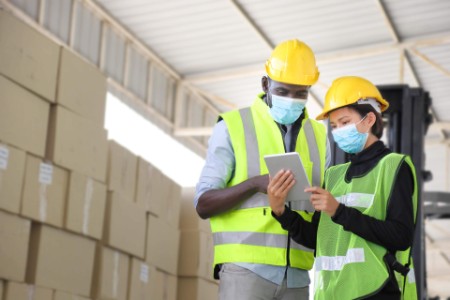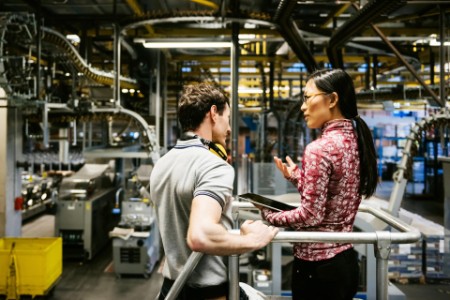
Chapter 1
Economic outlook
Driven by favorable factors in key sectors, SEA can help shape the global supply chain environment.
Despite a contraction in the real GDP of SEA in 2020, the International Monetary Fund expects the region’s growth to remain at 3%-5% in 2021–25.3 Notably, the region’s growing trade and strong fiscal policies have helped to boost growth of its manufacturing and service sectors.
At the same time, Industry 4.0 is transforming how entities optimize their manufacturing processes. Manufacturers in SEA are leveraging digital technologies such as advanced manufacturing methods, human-machine interaction, advanced analytics and intelligence to overcome low productivity concerns and further strengthen their position as “factories of the world”.
The following sectors are expected to see strong growth in the post-pandemic era:
Consumer goods
The consumer goods sector comprises home care, personal care and apparel. A shift in consumer purchase patterns, support from government institutions and economic integration toward a digital infrastructure are improving the overall feasibility of the sector’s expansion in SEA. The emergence of super apps across SEA has also altered how people engage and purchase within the apps, bringing significant growth opportunities for the sector.
Health care equipment
The health care equipment market in SEA is expected to see strong growth. In particular, Singapore is among the fastest-growing innovative production hubs of this sector. A favorable business environment, strong intellectual property laws, an expansive research network and incentives provide conducive reasons for companies to pursue new opportunities in the country and region. Further, SEA is enjoying strong growth in telehealth, digital therapeutics, diagnostics, remote patient monitoring and analytics.
Electronic manufacturing services (EMS)
Opportunities in the region’s EMS sector are opening up as entities seek to develop more resilient supply chain networks and expand into the region. Notably, 6 of the world’s top 10 EMS companies are present in Singapore.
Agritech
With an increasing focus on healthy food options and sustainability, the agritech sector is growing at a rapid pace in SEA. SEA received approximately US$700m of agrifoodtech-related investments in 2020, with a significant proportion going to Singapore.4

Chapter 2
Avoid pitfalls for greater supply chain resilience
As manufacturers leverage opportunities in SEA, they need to address key gaps to enhance supply chain resilience.
While the aforementioned opportunities bode well for the region’s longer-term economic growth, manufacturers need to look out for several pitfalls. Consumers increasingly demand convenience and personalization in e-commerce as a result of movement restrictions during the pandemic. Although manufacturers are aware of the importance of online channels, they may be slow to capture this market segment due to a lack of agility required to repivot supply chains for e-commerce. Nearshoring and near sourcing provide the flexibility to respond to consumer behavior faster. Companies can also incorporate personalization by manufacturing products to order instead of building huge inventories.
Without real-time, accurate data across the supply chain and investment in data analysis, manufacturers will not be able to efficiently forecast consumer demand, affecting supply chain agility in the face of rapid changes. An end-to-end solution that integrates all requirements across the supply chain and provides real-time insights, such as a digital control tower, can make supply chain management efficient and agile.
As consumers increasingly favor companies with sustainable and goal-oriented practices, manufacturers must be confident that their entire supply chain upholds sustainability standards. Committing to sustainable practices will put pressure on margins and require manufacturers to rethink various parts of their supply chains to strike a balance between consumer expectations and profits.
Reliance on third parties for critical components makes the supply chain susceptible to disruptions, with exposure to risks such as regulatory compliance, quality assurance or misappropriation of the company’s intellectual property. Companies should undertake a diligent review of the supply chain to analyze the risk profile of third parties. They should also consider entering contracts with different suppliers across geographies to diversify the sourcing of components.
A lack of skilled talent to assist in the high-tech supply chain can delay the setting up of R&D, manufacturing and supply chain capabilities in the region. Besides leveraging government support, companies should also train employees to run the supply chain efficiently.

Chapter 3
Design supply chains of the future
Manufacturers must prepare for major shifts that will impact the traditional supply chain.
The pandemic has exposed the fragility and inherent inefficiencies of traditional supply chains, with industries caught off guard and routine operations impacted. The just-in-time methodology that many companies relied on for the supply chain was developed in the 1970s and designed to optimize the supply chain through reduction of inventory and work processes. However, many industries today have complex supply chains and face significant pressure to achieve a cost advantage by sourcing materials and conducting value-addition activities across multiple geographies, making unfettered interconnectivity the primary key to success.
Four major shifts are expected to impact the traditional supply chain.
Acceleration of online retail penetration
With distancing measures and the pandemic transforming gradually into an endemic, online retail penetration will continue to accelerate in the next few years. Estimates indicate that online retail in SEA will jump from US$19b in 2018 to US$53b in 2023.5 In addition, the region’s digital economy is projected to exceed US$240b by 2025.6
Shifting and expansion of new business models
There are new developments in how products and services are presented to and consumed by consumers. An example is the development of community platforms, which enable multichannel engagement directly with consumers through gamification and personalization.
Supply chains will become complex and agile
Combining physical shopfront, online and mobile app presence that companies use to better connect with customers, the omnichannel outreach also means companies may need to leverage predictive and demand forecasting capabilities to improve merchandise planning and product development.
Supply chain optimization will become an important driver in decision-making
The supply chain strategy will shift from focusing only on traditional costs such as logistics and warehousing to also include the impact of lost sales, inventory holding and obsolescence costs.
Further, global trade tensions have indicated that the political landscape may face heightened uncertainty and challenges in the decade ahead. With SEA nations now being increasingly seen as low-cost manufacturing hubs, there is a key opportunity for companies to diversify and develop a resilient supply chain, while reducing overheads in the long run.
For this, the requisites of a resilient supply chain include the following.
Speed
Customers expect suppliers to anticipate their needs. With the pace of change, supply chains must be able to adapt quickly to match fast-changing customer preferences.
From linear to digitally networked supply chain
Although most companies are evolving from a linear supply chain, many do not consider themselves digitally networked or autonomous. Supply chains are moving to become a networked ecosystem where all data is in the cloud, and any event can be seen and acted on by players across the value chain simultaneously.
Supply chain investment priorities
A key goal is to adopt and pilot emerging technologies with scale in mind — not as an afterthought. Traditionally, supply chains were viewed as a cost center. However, going forward, decision-makers should see their supply chain as a way to effectively compete in the marketplace and steer strategy.
Overcoming talent shortage
People are the backbone of an entity, and as the industry transforms, so must the talent that drives it. Supply chain leaders need to drive the vision and rethink ways of working to attract and retain the right talent. The workforce must transform through retraining, recruitment and retention as the business reinvents its supply chain for resiliency.
To remain resilient, the supply chain must be able to quickly match fast-changing customer preferences and become digitally networked. It must also leverage emerging technologies with scale in mind and not as an afterthought. It is also important for the workforce to transform as the business reinvents its supply chain for resiliency.
Supply chains of the future should also be redesigned with responsiveness, reconfiguration and resilience in mind. For responsiveness, it is important to note that systems respond to inputs from the external environment. The supply chain system relies on inputs such as customer order volume, commodity prices and freight rates to act. Therefore, businesses should appreciate the value of real-time updates on these inputs by upgrading from legacy systems.
In terms of reconfiguration, diversifying one’s supply chain is not as simple as building additional plants in other jurisdictions. Instead, it involves redesigning functions in the system to be more “plug-and-play”. For example, in extreme events such as flooding, can certain business functions like procurement and finance continue their operations from other less affected locations? What are the necessary changes to enable that?
For resilience, companies need to think bigger and be prepared to build resiliency from the ground up, starting with the organization structure, business processes and performance metrics to futureproof against the next disruptive event. There is no “one-size-fits-all” for what this looks like, as every business is different.
Incorporating digital capabilities to enhance the supply chain
As corporate executives seek to reframe their businesses for the post-pandemic era, they should also be looking for opportunities to integrate digital capabilities to generate financial value and prioritize the development of a transformational culture in their organizations.
The development of smart factories, supply chain control towers and supply chain intelligence platforms can create end-to-end visibility through the collection of accurate cloud data to support real-time decisions for all ecosystem partners. The improvement in infrastructure shall add an additional stimulus for development. Notably, successful organizations are transforming their internal culture from one of “digital also” to that of “digital first”.

Chapter 4
What to consider in a supply chain strategy fit for the future
Companies must address several critical factors to design a supply chain that can withstand future disruptions.
Multinational companies have traditionally leveraged economies of scale, standardization and centralization to drive efficiencies. However, this strategy is not always fit for purpose for a diverse SEA market. Language, culture, the geographic landscape, regulatory and tax regimes, economic maturity and a fragmented consumer base all challenge the replication of such global models in SEA.
Further, companies are increasingly moving away from heavily centralized, co-located operating models to hybrid structures, which allow better management of regional differences and balance growth, cost and agility objectives. In addition, the pandemic has challenged the notion that co-location is required, with virtual centralization likely more prevalent going forward.
To tailor their regional supply chain strategies for the future, companies must consider eight critical factors:
- Customer collaboration and order fulfillment: covering inventory, warehousing, logistics and last-mile delivery planning to meet consumer expectations for quick delivery and prompt return services
- Regional trade and tax value chain optimization: having an ideal positioning between jurisdictions to optimize total cost-to-serve associated with procuring, manufacturing, importing, transporting, distributing and selling goods
- Footprint, assets and investments: possessing the right level of geographic decentralization to serve high-growth markets at compelling costs
- Supply chain visibility, intelligence and traceability: having a well-integrated supply chain with minimum interruption and maximum collaboration
- Product innovation: having the right balance between product standardization and product tailoring to country-specific requirements and at what stage of the supply chain
- Supply chain resiliency and sustainability at different stages: reducing dependence on a narrow set of global vendors and increased reliance on local sourcing at competitive prices
- Workforce restructuring and upskilling: a workforce not only technically competent, but also equipped with strategic thinking and problem-solving capabilities at different stages
- Digital enablement: bringing to life the various principles of Industry 4.0 and providing a much-needed boost to manufacturing efficiency and flexibility, labor productivity and workplace safety
While considering the above factors, companies should adopt a step-by-step approach to shape their regional supply chain strategies. The strategy should be defined in sync with short-, medium- and long-term business goals and objectives; nuances of various business segments defined by geographies, products and channels; the current supply chain’s robustness and potential gaps while scaling up the business. Eventually, it should take a segmented approach for different business segments to develop the supply chain strategy for SEA.
Companies can shape manufacturing and supply chain capabilities in SEA into a competitive advantage by investing in custom-fit models optimized for business needs. This also depends on where businesses are at across the three dimensions of asset ownership, consolidation and digitalization.
As companies worldwide seek to recover from the pandemic, it is now an opportune time for manufacturers to leverage the advantages of operating in SEA. To succeed in this endeavor, they will need to navigate the diversity of countries in the region and tailor their regional supply chain strategies for resilience against unexpected crises.
Summary
With its geographic, regulatory, economic and demographic advantages, Southeast Asia (SEA) offers favorable opportunities for manufacturers expanding into the region. However, they must be mindful of pitfalls as they navigate the diverse market and redesign their supply chains for resilience against unexpected disruptions. Incorporating advanced digital capabilities into the supply chain is also critical to address shifts in the marketplace with agility.


